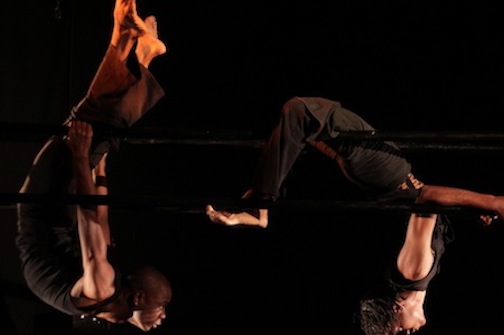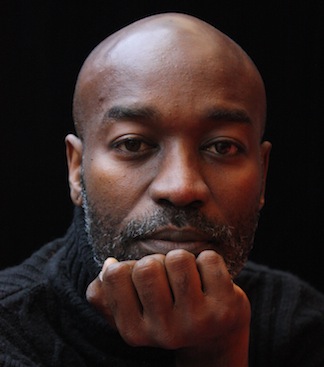Above: Johnnoiry St Philippe and Wenchel Renaudin of Ayikodans (Photo: Josue Azor)
By Alexander Britell
“When you are doing a dance class, you don’t need to speak English or Creole or French to do it — you just need to feel the energy, you just need to show the emotion,” says choreographer Jeanguy Saintus. “I think dance is the closest way to get people to talk to each other.”
Saintus leads Ayikodans, Haiti’s leading dance company, which, for nearly 25 years, has brought that energy and emotion to Haitian stages.
Saintus, who lives in Port-au-Prince, has worked to build a platform for dance in the country, despite largely nonexistent financial help for the group. But thanks in large part to Miami’s Adrienne Arsht Center for the Performing Arts, the group has found new life — and new support — in Miami.
Tonight, for the second year in a row, the 19-member Ayikodans brings its mix of contemporary and traditional repertoire to the Arsht Center.
After the January 2010 earthquake in Haiti, the future looked quite bleak for Ayikodans, however.
The quake damaged a part of its studio, and domestic funding for the group was nowhere to be found.
That’s when John Richard, president and CEO of Miami’s Arsht Center, stepped in.
Shortly after the quake, he ran into John Yearwood, the Miami Herald’s World Editor, and a “huge fan” of Ayikodans, according to Richard.
“He told me what was happening to the company and the damage to their building, and we got really interested in figuring out how we could be of help and assistance in Haiti,” Richard tells Caribbean Journal.
While relief agencies and health care institutions were doing their part, Richard wondered how an arts organization could contribute to the country’s recovery.
So Richard traveled to Haiti in the summer of 2010 and watched Ayikodans perform.
“We really thought the world of what the dancers were doing,” Richard says. “Our conversation progressed, and Jeanguy said, ‘I’m not going to make it — I think the company is going to go under.’ And we decided, well, we can’t let that happen.”
Shortly thereafter, the Arsht Center decided to invite the group to Miami to perform — creating a grassroots fund to raise money for Ayikodans. They sold out all three performances in 2011, and raised a total of $117,000, he said.
Tonight, the group will begin a two-day run with the debut two new works: Danse de L’Araignee (“Dance of the Spider”) and Anmwey Haiti Manman (“Cry Haiti Mother”).
It’s a significant shift from the group’s experience at home.
“In Haiti, my work is never commissioned — you’re walking on the beach, and you don’t know if you will ever present it,” Saintus says. “You will do it and you will forget about it. So I never had the chance to take my work, to see it, to take it to a theatre. So it’s a great help.”
Despite the lack of support, Saintus has spent more than a decade running a programme of his own to provide young Haitians with free classes and access to dance.
And now, with the Arsht Center’s help, Ayikodans is broadening its global reach.
According to Richard, several institutions are interested in presenting Ayikodans on their progammes next season.
“Jeanguy decided to keep his company together, under really dire circumstances and against all odds, and they have succeeded so far,” he says. “The real key here is to help promote and find more work for this company, because it’s the work that really counts.”
Saintus hopes his work will inspire support for art in Haiti.
“If we get more support from the audience, maybe that will push the people in Haiti, the private sector or the government to really invest in art, not just using it when they’re doing the political process,” he says.
Saintus says that could go a long way in helping to put the country back together.
“Maybe with the example of what the Arsht Center is doing with us, through dance, through Haitian traditional song, maybe that will help Haiti rebuild somehow,” he says. “I think with true art, there are a lot of things you can do — to rebuild the country, to rebuild hope, instead of just talking about reconstruction.”


